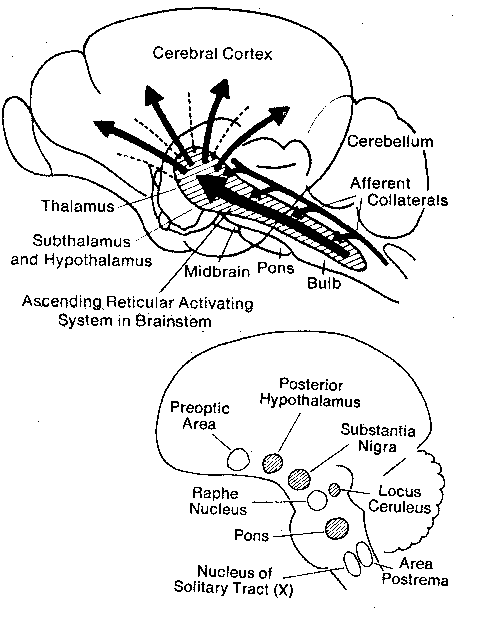Reticular activating system
From Psy3242
(Difference between revisions)
DMCGAUGHEY (Talk | contribs) |
DMCGAUGHEY (Talk | contribs) (→Overview) |
||
| Line 6: | Line 6: | ||
== Overview == | == Overview == | ||
| - | The '''reticular activating system''' or '''reticular formation''' is a structure that sits between the medulla oblongata and midbrain and branches into the brain stem. [http://en.wikipedia.org/wiki/Reticular_activating_system] This system dictates the level of arousal or consciousness for the cortex. Sensory and motor impulses travel in between the cerebral cortex, the thalamus, and the RF; this process influences the degree of alertness (or sleep) in a person (Stirling 8). | + | The '''reticular activating system''' or '''reticular formation''' is a structure that sits between the medulla oblongata and midbrain and branches into the brain stem. [http://en.wikipedia.org/wiki/Reticular_activating_system] This system dictates the level of arousal or consciousness for the cortex. Sensory and motor impulses travel in between the cerebral cortex, the thalamus, and the RF; this process influences the degree of alertness (or sleep) in a person (Stirling 8) as well as circadian rhythms, respiration, and heartbeat patterns. [http://en.wikipedia.org/wiki/Reticular_activating_system] |
| - | + | ||
== Relation to types of brain damage == | == Relation to types of brain damage == | ||
Revision as of 01:02, 29 April 2008
[Image:  ]
]
Overview
The reticular activating system or reticular formation is a structure that sits between the medulla oblongata and midbrain and branches into the brain stem. [1] This system dictates the level of arousal or consciousness for the cortex. Sensory and motor impulses travel in between the cerebral cortex, the thalamus, and the RF; this process influences the degree of alertness (or sleep) in a person (Stirling 8) as well as circadian rhythms, respiration, and heartbeat patterns. [2]
Relation to types of brain damage
In the case of hemineglect, or an unresponsiveness to
References
Stirling, John. Introducing Neuropsychology. New York: Psychology Press, 200
